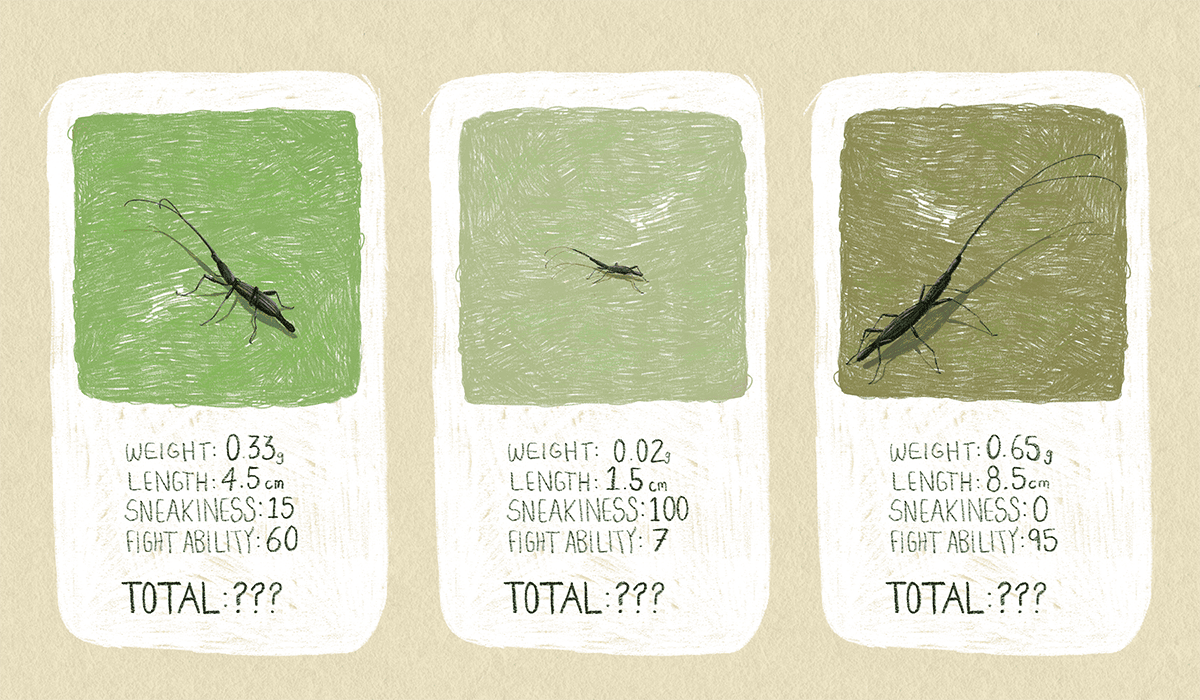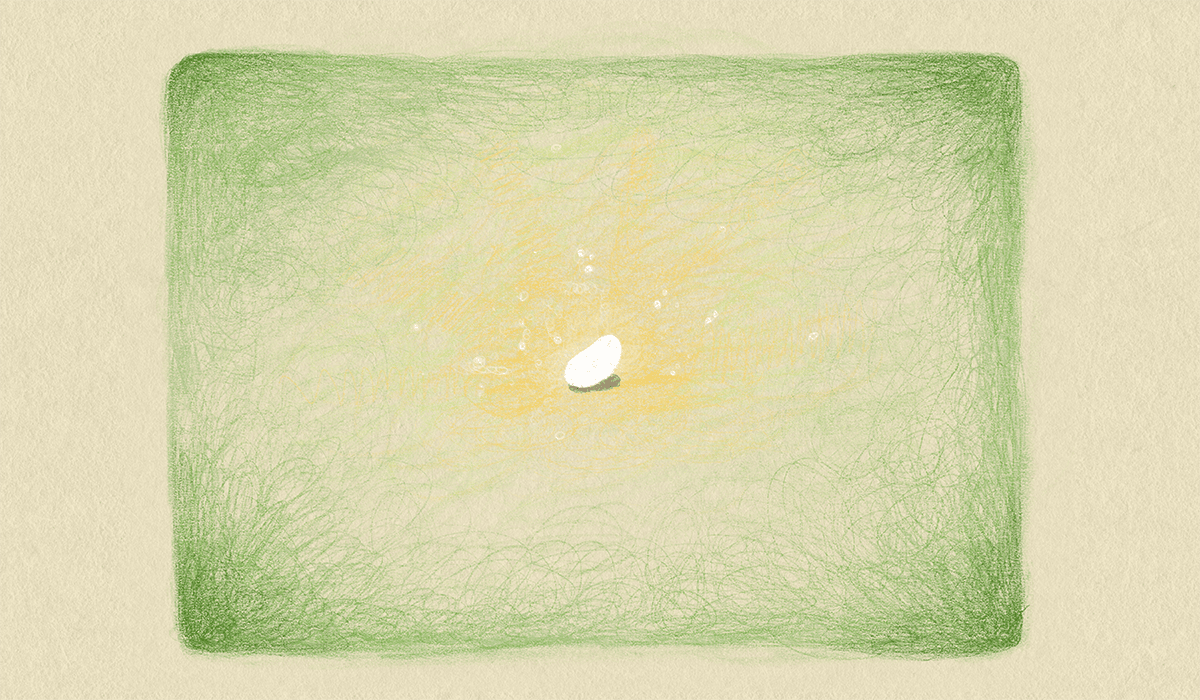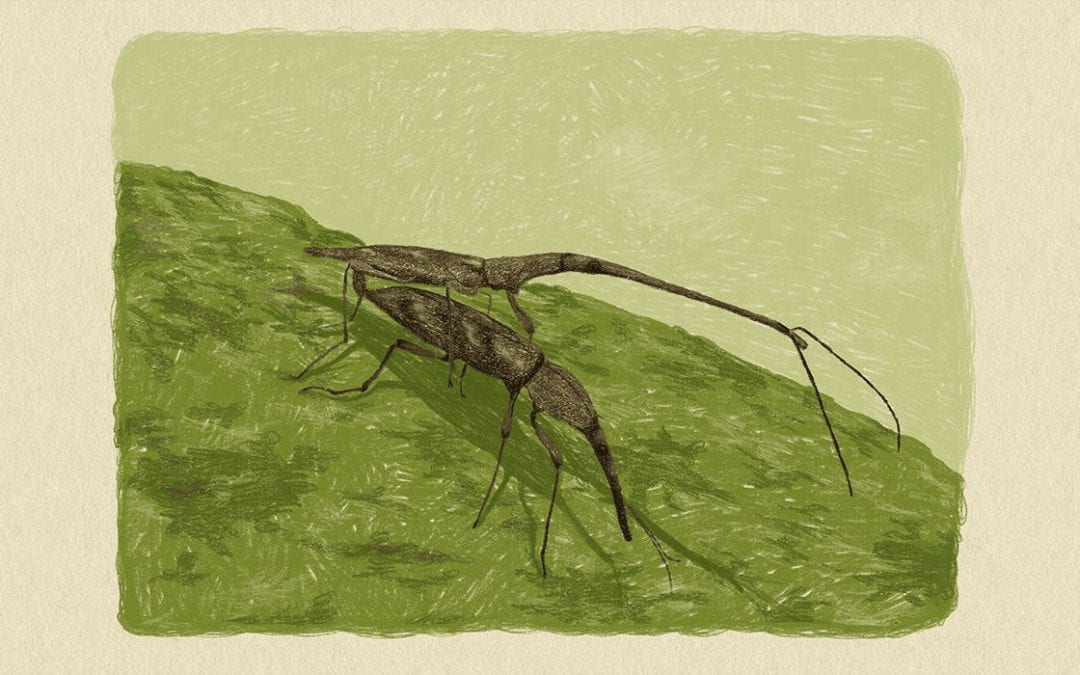2 June 2023
A collaboration between scientist Chrissie Painting and illustrator Jean Donaldson. Edited by Anna Brown.
“Found some!” I let out a sigh of relief and turn towards my colleague’s voice coming somewhere from among a tangle of logs and vines. Above me a kākā whistles, but this charismatic clown is not who we’re here to see.
I climb awkwardly over a huge fallen tawa and find my co-researcher Ummat crouched down staring at a pair of pepeke nguturoa* (New Zealand giraffe weevils). The male giraffe weevil is about the length of a clothes peg, and he’s standing guard over a smaller female, who is painstakingly using her drill-shaped head to carve out a hole in the tree to safely deposit her egg.
We open our backpacks, grab our binoculars, notebooks, and stopwatches, and start watching the pair. It takes four hours, but the female eventually turns around and starts to lay her egg into the carefully prepared hole. During that time we watch three different males mating with her – our original friend who we met at the start of the day, as well as a tiny male about a fifth of his size, who creeps underneath the guarding male and sneakily mates with the female. The third male is so long he towers over both the other males.
All of these weevils are painted with little numbers that act as ID badges, their size measured and a bit of leg tissue clipped to use for DNA analysis. Only one of these males can father the single tiny egg that has been laid into the tree.

We are peeking at the sex lives of giraffe weevils to answer a question that has been rattling around in my brain for years. How does the potent force of competition to pass on genes shape an animal’s behaviour and appearance? Being bigger is partly the answer to being successful if you’re a giraffe weevil. Bigger males are more likely to win fights with competing males and get the chance to mate. Males use their ridiculously elongated head like a jousting pole to throw their opponent off the tree in an attempt to secure mating opportunities. Goofy, but effective.
However, getting to mate doesn’t necessarily mean getting to be a dad. Across animals, the majority of females mate with multiple males. Females often store sperm from these suitors in their reproductive tracts, where those sperm literally race to successfully fertilise an egg. The result is an astonishing array of adaptations that evolve as a response to this secretive competition that continues after mating.
Sperm competition is like entering a lottery – the more tickets (sperm) you buy, the more chances you have to win (fertilisation). In deer mice, sperm clumps together to form a cooperative bundle that races towards the egg, male damselflies have spoon-like penises that scrape out the sperm from a female’s previous rendezvous, and male scorpionflies can assess how much sperm a female is storing and adjust their ejaculate size in response.
Back in the bush, we are watching our female rock her body back and forth, scraping microscopic bits of bark to plug the hole where she’s laid her egg, making it invisible to onlookers. Neither of us speaks, as this part of the observation is crucial – we need to pinpoint the exact spot that the female has laid her egg. I’m drawing a map in my mind: one centimetre from the lightning-shaped crack, just below the bubbly lichen and between those two black specks. I reach tentatively across to the tree, draw a bright red dot on top of the covered hole and then glue a bottle cap over it. A week later we return to the tree and carefully extract the egg using wood-carving tools and all the patience we can muster.

Once plucked out, the egg is the size of a fairy sprinkle. This precious packet contains answers to our mystery. DNA genotyping will reveal the father, and which aspects of his biology make him successful. Is it the length of his weapon? The order in which he mated? Or maybe it’s how long he got to mate for.
We will watch many more episodes of this epic sex saga. Combined, these observations will reveal the intricate secrets of giraffe weevil mating behaviour, and ultimately, tell us a little bit more about how evolution is responsible for driving diversity in Earth’s creatures.
*I’ve not been able to find much information about the Māori names for the giraffe weevil but pepeke nguturoa loosely translates to ‘long-beaked beetle/insect’, in reference to the male’s elongated rostrum. Giraffe weevils are also known as tūwhaipapa and tūwhaitara, which is said to refer to the atua of newly made canoes and alludes to the beetle’s long canoe-like body. The giraffe weevil’s scientific name Lasiorhynchus barbicornis also has an interesting etymology, with ‘lasios’ meaning densely hairy, ‘rhynchos’ meaning proboscis, ‘barbi’ meaning beard and ‘corni’ meaning horn. That means both the genus and species name are referring to the male’s super hairy moustache that runs along the underside of its rostrum!
Chrissie Painting is a Principal Investigator with Te Pūnaha Matatini, with a particular fascination for insect mating systems and a passion for raising the awareness of the littlest creatures of Aotearoa.
Jean Donaldson is a designer and native bird fanatic based in Te Whanganui-a-Tara. You can see more of her work at https://jeanmanudesign.com/.

